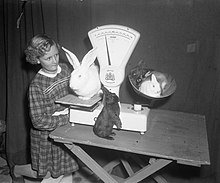Breed name
|
Image
|
Size
|
Fur
type
|
Ear
type
|
Colors & markings
|
ARBA
recognized?
|
BRC
recognized?
|
Origin
|
| Alaska |
 |
7–9 lb
(3.2–4.1 kg) |
Short |
Erect |
Black |
No |
Yes |
 European Union European Union
 Germany Germany
|
| Altex |
|
13 lb
(5.9 kg) |
Short |
Erect |
Pointed White |
No |
No |
 United States United States
 Alabama Alabama
 Texas Texas
|
| American |
 |
9–12 lb
(4.1–5.4 kg) |
Short |
Erect |
Blue, White |
Yes |
No |
 United States United States
 California California
|
American Chinchilla [US]
See also:
Chinchilla |
 |
9–12 lb
(4.1–5.4 kg) |
Short |
Erect |
Chinchilla |
Yes |
No |
 United States United States
|
| American Fuzzy Lop |
 |
3.5–4 lb
(1.6–1.8 kg) |
Long |
Lop |
[All solid or broken colors/patterns] |
Yes |
No |
 United States United States
|
| American Sable |
 |
7–10 lb
(3.2–4.5 kg) |
Short |
Erect |
Sable |
Yes |
No |
 United States United States
 California California
|
| Angora |
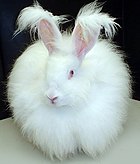 |
4.4–12.1 lb
(2.0–5.5 kg) |
Short |
Erect |
Albino or Colored |
Yes |
Yes |
 Turkey Turkey
|
| Argente Bleu |
Image |
6 lb
(2.7 kg) |
Short |
Erect |
[Argente Bleu markings] |
No |
Yes |
 European Union European Union
 France France
|
| Argente Brun [UK] |
Image |
6 lb
(2.7 kg) |
Short |
Erect |
[Argente Brun [UK] markings] |
No |
Yes |
 United Kingdom United Kingdom
 England England
|
| Argente Brun [US] |
Image |
8–10.5 lb
(3.6–4.8 kg) |
Medium |
Erect |
[Argente Brun [US] markings] |
Yes |
No |
 Canada Canada
|
| Argente Clair |
Image |
6 lb
(2.7 kg) |
Short |
Erect |
[Blue base heavily silvered] |
No |
No |
 European Union European Union
 France France
|
Argente Crème [UK]
See also:
Creme d'Argent [US] |
Image |
5 lb
(2.3 kg) |
Short |
Erect |
[Argente Crème markings] |
No |
Yes |
 European Union European Union
 France France
|
Argente de Champagne [UK]
See also:
Champagne d'Argent [US] |
 |
9–12 lb
(4.1–5.4 kg) |
Short |
Erect |
[Argente de Champagne markings] |
No |
Yes |
 European Union European Union
 France France
|
| Argente Noir |
Image |
6 lb
(2.7 kg) |
Short |
Erect |
[Argente Noir markings] |
No |
Yes |
 European Union European Union
 France France
|
| Argente St Hubert |
Image |
6 lb
(2.7 kg) |
Short |
Erect |
[Argente St Hubert markings] |
No |
Yes |
 European Union European Union
 France France
|
| Armenian Marder |
Image |
8.8–9.9 lb
(4.0–4.5 kg) |
Short |
Erect |
[Dark Brown or Light Brown (either having light to heavy chinchillation)] |
No |
No |
 Armenia Armenia
|
Astrex
See also:
Rex [US] |
Image |
6–8 lb
(2.7–3.6 kg) |
Rex
Curly
Short |
Erect |
"Any [BRC-]recognised Rex Colour." |
No |
Yes |
 United Kingdom United Kingdom
 England England
|
| Aurora Negro |
 |
— |
— |
— |
— |
No |
No |
 Guatemala Guatemala
|
| Baladi Black |
 |
6.0 lb
(2.7 kg) |
Short |
Erect |
Black |
No |
No |
 Egypt Egypt
|
| Baladi Red |
Image |
6.2 lb
(2.8 kg) |
Short |
Erect |
Red |
No |
No |
 Egypt Egypt
|
| Baladi White |
 |
4.3 lb
(1.95 kg) |
Short |
Erect |
White |
No |
No |
 Egypt Egypt
|
| Bauscat |
Image |
8 lb
(3.6 kg) |
Short |
Erect |
Albino |
No |
No |
 Egypt Egypt
|
Beige [UK]
See also:
Czech Solver [CZ]
Separator [DE] |
 |
5–6.5 lb
(2.3–2.9 kg) |
Short |
Erect |
"Dark Chamois or light sandy colour, down to the skin, faintly ticked with blue." |
No |
Yes |
 United Kingdom United Kingdom
|
| Belgian Hare [UK] |
 |
8–9 lb
(3.6–4.1 kg) |
Short |
Erect |
"Rich, deep chestnut red, well extended down the sides. Black ticking of a wavy or blotchy appearance, plentiful on body; chest and face free." |
No |
Yes |
 European Union European Union
 Belgium Belgium
|
| Belgian Hare [US] |
 |
8–9.5 lb
(3.6–4.3 kg) |
Short |
Erect |
"Deep red 'rufous' coat with black, wavy ticking." |
Yes |
No |
 European Union European Union
 Belgium Belgium
|
Beveren [UK]
See also:
Pointed Beveren |
Image
|
8 lb
(3.6 kg) |
Medium |
Erect |
Black, Blue, Brown, Lilac, White [with blue eyes] |
No |
Yes |
 European Union European Union
 Belgium Belgium
|
| Beveren [US] |
Image |
8–12 lb
(3.6–5.4 kg) |
Medium |
Erect |
Black, Blue, White [with blue eyes] |
Yes |
No |
 European Union European Union
 Belgium Belgium
|
Big Silver Marten
Also called:
Große Weißgrannen [de]
Veliki Bijeloopaljeni Kunić [hr]
See also:
Silver Marten |
 |
8–12 lb
(3.6–5.4 kg) |
Short |
Erect |
[Black, Blue, or Havana with white and/or tan markings, plus white ticking on the lower body] |
No |
No |
 European Union European Union
 Croatia Croatia
|
| Blanc de Bouscat |
 |
11–15.5 lb
(5.0–7.0 kg) |
Short |
Erect |
"Completely snow white [...]. Guard hairs sprinkled regularly all over the coat give it a brilliant frosty look." |
No |
Yes |
 European Union European Union
 France France
|
| Blanc de Hotot |
 |
8–11 lb
(3.6–5.0 kg) |
Short |
Erect |
White with dark rings around the eyes |
Yes |
Yes |
 European Union European Union
 France France
|
Blanc de Popielno
Also called:
Popielański Biały [pl]
Popielno White |
Image |
8.8–11.0 lb
(4–5 kg) |
Short |
Erect |
Albino |
No |
No |
 European Union European Union
 Poland Poland
|
| Blanc de Termonde |
Image |
9–12 lb
(4.1–5.4 kg) |
Short |
Erect |
"Immaculately white. Eyes are ruby red" |
No |
Yes |
 European Union European Union
 Belgium Belgium
|
| Blue of Ham |
Image |
9.9–13.2 lb
(4.5–6 kg) |
Long |
Erect |
"Slate blue with a blue sub-color" but "not as dark as the blue Vienna" |
No |
No |
 European Union European Union
 Belgium Belgium
|
| Blue of Sint-Niklaas |
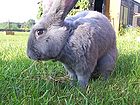 |
5–12 lb
(2.3–5.4 kg) |
Short |
Erect |
Blue |
No |
No |
 European Union European Union
 Belgium Belgium
|
Bourbonnais Grey
Also called:
Gris du Bourbonnais [fr] |
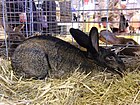 |
7–11 lb
(3.2–5.0 kg) |
Short |
Erect |
"Overall color is slate blue with longer gray guard hairs tipped black." |
No |
No |
 European Union European Union
 France France
|
| Brazilian |
Image |
7–11 lb
(3.2–5.0 kg) |
Short |
Erect |
— |
No |
No |
 Brazil Brazil
|
Britannia Petite [US]
See also:
Polish [UK] |
 |
1.5–2.5 lb
(0.68–1.13 kg) |
Short |
Erect |
Black, Black Otter, Blue-Eyed White, Chestnut, Red-Eyed White, Sable Marten |
Yes |
No
|
| British Giant |
 |
12.5–25 lb
(5.7–11.3 kg) |
Short |
Erect |
Black, Blue, Brown Grey, Dark Steel Grey, Opal, White |
No |
Yes |
 United Kingdom United Kingdom
 England England
|
Brown Chestnut of Lorraine
Also called:
Brun Marron de Lorraine [fr] |
Image |
4.4–5.3 lb
(2.0–2.4 kg) |
Short |
Erect |
"Chestnut brown uniform color with a well-defined orange-brown outer-color. Under-color bluish including the belly. Ears bluish on their inner side and edged with a black border." |
No |
No |
 European Union European Union
 France France
|
| Caldes |
Image |
9.5–9.9 lb
(4.3–4.5 kg) |
Short |
Erect |
Red-Eyed White |
No |
No |
 European Union European Union
 Spain Spain
|
| Californian [UK] |
 |
7.5–9.5 lb
(3.4–4.3 kg) |
Short |
Erect |
Four varieties, all being white (with red eyes) with dark points:
Normal ("dark sepia" points), Chocolate ("milk chocolate" points),
Blue ("slate blue" points), or Lilac ("pink shade of dove" points) |
No |
Yes |
 United States United States
 California California
|
| Californian [US] |
 |
9–10.5 lb
(4.1–4.8 kg) |
Short |
Erect |
One variety, being white (with red eyes) with dark points:
Standard (black points) |
Yes |
No |
 United States United States
 California California
|
Canadian Plush Lop
See also:
Rex [US] |
Image |
3.5–6.5 lb
(1.6–2.9 kg) |
Rex
Curly
Medium |
Lop |
[Includes at least 19 stated colors/patterns] |
No |
No |
 Canada Canada
|
| Carmagnola Grey |
Image |
7.7–9.9 lb
(3.5–4.5 kg) |
Short |
Erect |
[Chinchilla] |
No |
No |
 European Union European Union
 Italy Italy
|
Cashmere Lop
See also:
Miniature Cashmere Lop |
 |
4.25–5.25 lb
(1.93–2.38 kg) |
Long |
Lop |
[Includes >35 different colors/patterns] |
No |
Yes |
 United Kingdom United Kingdom
 England England
|
Champagne d'Argent [US]
See also:
Argente de Champagne [UK] |
 |
9–12 lb
(4.1–5.4 kg) |
Short |
Erect |
[Champagne d'Argent markings] |
Yes |
No |
 European Union European Union
 France France
|
| Chaudry |
 |
8–9 lb
(3.6–4.1 kg) |
Short |
Erect |
Red-Eyed White |
No |
No |
 European Union European Union
 France France
|
Checkered Giant [US]
See also:
Giant Papillon [UK] |
 |
11–25 lb
(5.0–11.3 kg) |
Short |
Erect |
Black (i.e, white with black markings), Blue (i.e., white with gray markings) |
Yes |
No |
 European Union European Union
 Germany Germany
|
Chinchilla
See main entries:
American Chinchilla [US]
Chinchilla [UK]
Chinchilla Giganta [UK]
Giant Chinchilla [US]
Standard Chinchilla [US] |
— |
— |
— |
— |
— |
— |
— |
—
|
| Chinchilla [UK] |
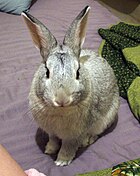 |
7 lb
(3.2 kg) |
Short |
Erect |
"To resemble real Chinchilla." |
No |
Yes |
 European Union European Union
 France France
|
| Chinchilla Giganta [UK] |
 |
8.5–12 lb
(3.9–5.4 kg) |
Short |
Erect |
[Chinchilla, but with] "Desired top colour considerably darker grey than the Chinchilla [i.e., Chinchilla [UK]] rabbit." |
No |
Yes |
 European Union European Union
 France France
|
| Cinnamon |
Image |
10–11 lb
(4.5–5.0 kg) |
Short |
Erect |
Cinnamon |
Yes |
No |
 United States United States
 Montana Montana
|
| Continental Giant Coloured |
Image |
12.4–25 lb
(5.6–11.3 kg) |
Short |
Erect |
Agouti, Black, Chinchilla, Dark Steel, Light Steel, Opal, Red Agouti, Yellow |
No |
Yes |
 European Union European Union
|
| Continental Giant White |
Image |
11–25 lb
(5.0–11.3 kg) |
Short |
Erect |
"Immaculate white, eyes pink or blue." |
No |
Yes |
 European Union European Union
|
Creme d'Argent [US]
See also:
Argente Crème [UK] |
Image |
8–11 lb
(3.6–5.0 kg) |
Short |
Erect |
"Creamy white with an orange cast" |
Yes |
No |
 European Union European Union
 France France
|
| Criollo |
 |
3–4 lb
(1.4–1.8 kg) |
Short |
Erect |
"Many colors and patterns." |
No |
No |
 Mexico Mexico
|
| Cuban Brown |
 |
9.9–11.0 lb
(4.5–5 kg) |
Short |
Erect |
Glossy brown |
No |
No |
 Cuba Cuba
|
| Czech Red |
 |
4–5 lb
(1.8–2.3 kg) |
Short |
Erect |
Chestnut |
No |
No
|
Czech Solver [CZ]
Also called:
Český Luštič
See also:
Beige [UK]
Separator [DE] |
 |
7.9–8.6 lb
(3.6–3.9 kg) |
Short |
Erect |
[sandy colored] |
No |
No |
 European Union European Union
 Czech Republic Czech Republic
|
| Czech Spot |
 |
6–8 lb
(2.7–3.6 kg) |
Short |
Erect |
Agouti, Black, Blue, Isabella (Beige), Tortoise, Tri-color |
No |
No |
 European Union European Union
 Czech Republic Czech Republic
|
Czech White
Also called:
Český Albín |
 |
8.8–11.0 lb
(4.0–5.0 kg) |
Short |
Erect |
White |
No |
No |
 European Union European Union
 Czech Republic Czech Republic
|
| Dalmatian |
 |
6–8 lb
(2.7–3.6 kg) |
Rex
Straight
Short |
Erect |
White with "numerous little coloured patches" of "black, blue, brown, orange, or fawn". |
No |
Yes |
 European Union European Union
 France France
|
| Deilenaar |
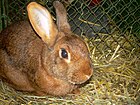 |
5–8 lb
(2.3–3.6 kg) |
Short |
Erect |
Red Agouti |
No |
Yes |
 European Union European Union
 Netherlands Netherlands
|
| Dutch [UK] |
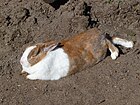 |
4.5–5 lb
(2.0–2.3 kg) |
Short |
Erect |
["Dutch" markings on] Black, Blue, Brown Grey, Chocolate, Pale Grey, Steel Grey, Tortoiseshell, Yellow |
No |
Yes |
 United Kingdom United Kingdom
 England England
|
| Dutch [US] |
 |
3.5–5.5 lb
(1.6–2.5 kg) |
Short |
Erect |
Black Dutch, Blue Dutch, Chinchilla Dutch, Chocolate Dutch, Gray Dutch, Steel Dutch, Tortoise Dutch |
Yes |
No |
 United Kingdom United Kingdom
 England England
|
Dutch (Tri-Colour)
See main entry:
Tri-Colour Dutch |
— |
— |
— |
— |
— |
— |
— |
—
|
| Dwarf Hotot |
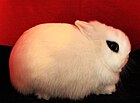 |
2–3 lb
(0.91–1.36 kg) |
Short |
Erect |
White with black around the eyes |
Yes |
No |
 European Union European Union
 Germany Germany
|
Dwarf Lop [UK]
See also:
Mini Lop [US] |
 |
4.25–5.25 lb
(1.93–2.38 kg) |
Short |
Lop |
[Many] |
No |
Yes |
 European Union European Union
 Germany Germany
|
Elfin
See main entry:
Swedish Hare |
— |
— |
— |
— |
— |
— |
— |
—
|
| Enderby Island |
 |
3–4 lb
(1.4–1.8 kg) |
Short |
Erect |
"Silver-grey" (with chinchillation) or "Cream or beige" |
No |
No |
 Australia * Australia *
|
| English Angora |
 |
5–8 lb
(2.3–3.6 kg) |
Long |
Erect |
[Many] |
Yes |
Yes |
 European Union European Union
 France France
|
| English Lop |
 |
10–11 lb
(4.5–5.0 kg) |
Short |
Lop |
[Many] |
Yes |
Yes |
 United Kingdom United Kingdom
 England England
|
| English Spot |
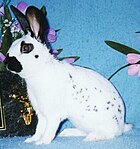 |
5–8 lb
(2.3–3.6 kg) |
Short |
Erect |
White with colored butterfly pattern |
Yes |
Yes |
 United Kingdom United Kingdom
 England England
|
| Fauve de Bourgogne |
 |
7–11 lb
(3.2–5.0 kg) |
Short |
Erect |
Orange/Red |
No |
Yes |
 European Union European Union
 France France
|
Fee de Marbourg
See main entry:
Marburger Feh [UK] |
— |
— |
— |
— |
— |
— |
— |
—
|
Feh de Marbourg [FR]
See main entry:
Marburger Feh [UK] |
— |
— |
— |
— |
— |
— |
— |
—
|
Feu Noir [FR]
See main entry:
Tan |
— |
— |
— |
— |
— |
— |
— |
—
|
| Flemish Giant [UK] |
 |
11–25 lb
(5.0–11.3 kg) |
Short |
Erect |
"Dark steel grey, with even or wavy ticking [...] except belly & under tail which shall be white [...]." |
No |
Yes |
 European Union European Union
 Belgium Belgium
|
| Flemish Giant [US] |
 |
14–25 lb
(6.4–11.3 kg) |
Short |
Erect |
Black, Blue, Fawn, Light Grey, Sandy, Steel, White |
Yes |
No |
 European Union European Union
 Belgium Belgium
|
| Florida White |
 |
4–6 lb
(1.8–2.7 kg) |
Short |
Erect |
White |
Yes |
No |
 United States United States
 Florida Florida
|
| Fox [de] |
Image |
6.6–11.0 lb
(3–5 kg) |
Long |
Erect |
"It is most common in the color white." |
No |
No |
 Switzerland Switzerland
|
Fox–Silver [UK]
See also:
Silver Fox [US] |
 |
5.5–7 lb
(2.5–3.2 kg) |
Short |
Erect |
Black, Blue, Chocolate, Lilac |
No |
Yes |
 United Kingdom United Kingdom
 England England
|
| French Angora |
 |
7.5–10.5 lb
(3.4–4.8 kg) |
Long |
Erect |
[Many] |
Yes |
No |
 European Union European Union
 France France
|
| French Lop |
 |
10 lb
(4.5 kg) |
Short |
Lop |
[Many] |
Yes |
Yes |
 European Union European Union
 France France
|
| Gabali |
Image |
6–7 lb
(2.7–3.2 kg) |
Short |
Erect |
Agouti |
No |
No |
 Egypt Egypt
|
| German Angora |
Image |
5.5–12.1 lb
(2.5–5.5 kg) |
Long |
Erect |
[Albino or colored (but not bi-colored)] |
No |
No |
 European Union European Union
 Germany Germany
|
| German Lop |
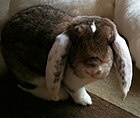 |
6–8 lb
(2.7–3.6 kg) |
Short |
Lop |
[Many] |
No |
Yes |
 European Union European Union
 Germany Germany
|
| Giant Angora |
 |
10 lb
(4.5 kg) |
Long |
Erect |
— |
Yes |
No |
 United States United States
 Massachusetts Massachusetts
|
Giant Chinchilla [US]
See also:
Chinchilla |
 |
10–16 lb
(4.5–7.3 kg) |
Short |
Erect |
Chinchilla |
Yes |
No |
 United States United States
 Missouri Missouri
|
Giant Havana
Also called:
Stor Havana [da]
Stora Havana [se]
See also:
Havana [UK]
Havana [US] |
Image |
10–11 lb
(4.6–5 kg) |
Short |
Erect |
"Dark brown and glossy color. The eyes are brown, but from certain points of view they are ruby red." |
No |
No |
 European Union European Union
 Sweden Sweden
|
Giant Marburger
Also called:
Stor Marburger Egern [da]
See also:
Marburger Feh [UK] |
Image |
10–11 lb
(4.6–5 kg) |
Medium |
Erect |
"A grey-blue outer color with a brownish undertone." |
No |
No |
 European Union European Union
 Denmark Denmark
|
Giant Papillon [UK]
See also:
Checkered Giant [US]
Miniature Papillon |
 |
11–25 lb
(5.0–11.3 kg) |
Short |
Erect |
[Colored butterfly, eye circles, cheek spots, ear base, saddle, and rump spots; all on a base of white.] "All [BRC] recognised colours are admissible." |
No |
Yes |
 European Union European Union
 Germany Germany
|
Giant Silver
Also called:
Stor Sølv [da]
Stora Sølv [se]
See also:
Silver [UK]
Silver [US] |
Image |
10–11 lb
(4.6–5 kg) |
Short |
Erect |
"The entire body has a black base color mixed with hair with white tips that gives the rabbit a silver sheen." |
No |
No |
 European Union European Union
 France France
|
Giant Smoke Pearl
Also called:
Stor Zobel [da]
Stora Zobel [se]
See also:
Smoke Pearl |
Image |
8.8–11.0 lb
(4–5 kg) |
Short |
Erect |
"A mixture of brown, so-called sepia-colored and beige tones" [with darker points]. |
No |
No |
 European Union European Union
 Germany Germany
|
| Giza White |
Image |
5.6–7.6 lb
(2.53–3.45 kg) |
Short |
Erect |
Albino |
No |
No |
 Egypt Egypt
|
| Golden Glavcot |
Image |
5–6 lb
(2.3–2.7 kg) |
Short |
Erect |
— |
No |
Yes |
 United Kingdom United Kingdom
 England England
|
| Gotland |
 |
6.6–9 lb
(3.0–4.1 kg) |
Short |
Erect |
— |
No |
No |
 European Union European Union
 Sweden Sweden
|
| Gouwenaar |
Image |
5.5–7.1 lb
(2.5–3.2 kg) |
Short |
Erect |
"The body color has a light grey-blue tone throughout the body." |
No |
No |
 European Union European Union
 Netherlands Netherlands
|
Grey Pearl of Halle
Also called:
Gris Perle de Hal
Lille Egern
Parelgrijze van Halle |
Image |
5.5–7.1 lb
(2.5–3.2 kg) |
Short |
Erect |
"The body color is a light grey-blue tone throughout the body." |
No |
No |
 European Union European Union
 Belgium Belgium
|
| Güzelçamlı |
 |
5–8 lb
(2.3–3.6 kg) |
Short |
Erect |
White with chocolate markings |
No |
No |
 Turkey Turkey
|
| Harlequin [UK] |
 |
6–8 lb
(2.7–3.6 kg) |
Short |
Erect |
Harlequin
(includes: Black, Blue, Brown, Lilac)
Magpie
(includes: Black, Blue, Brown, Lilac) |
No |
Yes |
 European Union European Union
 France France
|
| Harlequin [US] |
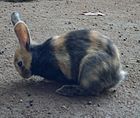 |
6–9 lb
(2.7–4.1 kg) |
Short |
Erect |
Japanese
(includes: Black, Blue, Chocolate, Lilac)
Magpie
(includes: Black, Blue, Chocolate, Lilac) |
Yes |
No |
 European Union European Union
 France France
|
Harlequin Dutch
See main entry:
Tri-Colour Dutch |
— |
— |
— |
— |
— |
— |
— |
—
|
Harlequin Rex
Also called:
Magpie Rex
Japanese Rex |
 |
6–8 lb
(2.7–3.6 kg) |
Rex
Straight
Short |
Erect |
[ Same as for Harlequin [UK] ] |
No |
Yes |
 European Union European Union
 France France
|
Havana [UK]
See also:
Giant Havana |
Image |
5.5–6.5 lb
(2.5–2.9 kg) |
Short |
Erect |
"A rich, dark chocolate with a purplish sheen, [...] pearl-grey undercolour." |
No |
Yes |
 European Union European Union
 Netherlands Netherlands
|
Havana [US]
See also:
Giant Havana |
 |
4.5–6.5 lb
(2.0–2.9 kg) |
Short |
Erect |
Black, Blue, Broken, Chocolate, Lilac |
Yes |
No |
 European Union European Union
 Netherlands Netherlands
|
Himalayan
Also called:
Russian |
 |
6–8 lb
(2.7–3.6 kg) |
Short |
Erect |
White with points of either black, blue, chocolate, or lilac |
Yes |
Yes |
 China China
|
Holland Lop [US]
See also:
Miniature Lop [UK/NL] |
 |
4–6.5 lb
(1.8–2.9 kg) |
Short |
Lop |
Agouti, Broken, Pointed White, Self Colors, Shaded Colors, Tan Pattern, Ticked, Wide Band |
Yes |
No |
 European Union European Union
 Netherlands Netherlands
|
| Hulstlander |
Image |
4–6 lb
(1.8–2.7 kg) |
Short |
Erect |
White with blue eyes |
No |
Yes |
 European Union European Union
 Netherlands Netherlands
|
| Hungarian Giant |
Image |
11–15 lb
(5–7 kg) |
Short |
Erect |
[Many] |
No |
No |
 European Union European Union
 Hungary Hungary
|
| Isabella |
Image |
6.6–8.8 lb
(3–4 kg) |
Short |
Erect |
"The yellowish brown color is 'coated' with a blue veil, caused by blue hair tips. In front of the head there is the 'mask', which when seen from the front, is oval." |
No |
No |
 European Union European Union
 Sweden Sweden
|
| Jamora [de] |
Image |
4.2–5.3 lb
(1.9–2.4 kg) |
Long |
Erect |
"[L]ike [Harlequin or] Japanese. The most common color is black / yellow, but black and white may occur." |
No |
No |
 European Union European Union
 Germany Germany
|
Japanese Dutch
See main entry:
Tri-Colour Dutch |
— |
— |
— |
— |
— |
— |
— |
—
|
Japanese White
Also called:
日本白色種 [ja]
Includes:
ジャンボうさぎ [ja]
Jumbo Usagi |
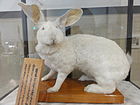 |
6.6–22.0 lb
(3–10 kg) |
Short |
Erect |
Albino |
No |
No |
 Japan Japan
|
| Jersey Wooly |
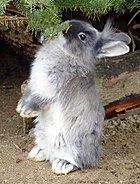 |
2.5–3.5 lb
(1.1–1.6 kg) |
Long |
Erect |
[Many] |
Yes |
No |
 United States United States
 New Jersey New Jersey
|
| Kabyle |
Image |
4.4–6.6 lb
(2.0–3.0 kg) |
Short |
Erect |
[Many] |
No |
No |
 Algeria Algeria
|
| Lilac [UK] |
Image |
5.5–7 lb
(2.5–3.2 kg) |
Short |
Erect |
"An even pink shade of dove colour" |
No |
Yes |
 United Kingdom United Kingdom
 England England
|
| Lilac [US] |
Image |
5–8 lb
(2.3–3.6 kg) |
Short |
Erect |
"Pinkish dove-gray" |
Yes |
No |
 United Kingdom United Kingdom
 England England
|
| Lionhead [UK] |
 |
3.0–3.7 lb
(1.36–1.7 kg) |
Long |
Erect |
"All [BRC] recognised colour[s] and pattern[s]" |
No |
Yes |
 European Union European Union
 France France
 Belgium Belgium
|
| Lionhead [US] |
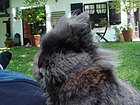 |
3.25–3.75 lb
(1.47–1.70 kg) |
Long |
Erect |
Chocolate, Ruby-Eyed White, Seal, Siamese Sable, Tortoise (includes Black, Blue, Chocolate, Lilac) |
Yes |
No |
 European Union European Union
 France France
 Belgium Belgium
|
Liptov Baldspotted Rabbit
Also called:
Liptovský lysko |
Image |
8.8–9.4 lb
(4–4.25 kg) |
Short |
Erect |
Agouti, Blue-Agouti, or Black |
No |
No |
 European Union European Union
 Slovakia Slovakia
|
Lynx
Also called:
Luchskaninchen
Lux |
Image |
5.5–7.1 lb
(2.5–3.2 kg) |
Short |
Erect |
"Lux has a wild factor and the outermost part of the hair is light grey. Under this color, the middle color is reddish-brown. The middle color is so high that it shines through the entire color. The entire color therefore appears as a reddish-brown tone 'coated' with a light grey-blue cut." |
No |
No |
 European Union European Union
 Germany Germany
|
Marburger Feh [UK]
Originally named:
Fee de Marbourg
Renamed:
Feh de Marbourg [FR]
See also:
Giant Marburger |
 |
4.15–7.2 lb
(1.88–3.27 kg) |
Short |
Erect |
[Lilac:] "The top colour is a delicately toned light blue which appears to be covered with a brownish veil." |
No |
Yes |
 European Union European Union
 France France
|
Mecklenburger Piebald
Also called:
Mecklenburger Schecke |
 |
9.9–12.1 lb
(4.5–5.5 kg) |
Medium |
Erect |
"[Broken pattern: mostly solid color with neck, chest, belly, legs. Includes Agouti, Black, Blue, Red, Steel]" |
No |
No |
 European Union European Union
 Germany Germany
|
| Meissner Lop |
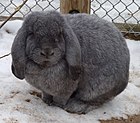 |
10–12 lb
(4.5–5.4 kg) |
Short |
Lop |
[Many] |
No |
Yes |
 European Union European Union
 Germany Germany
|
| Mellerud rabbit |
 |
6.6–7.7 lb
(3.0–3.5 kg) |
Short |
Erect |
Albino, Black with inexact "Dutch" markings |
No |
No |
 European Union European Union
 Sweden Sweden
|
Mini Cashmere Lop
See main entry:
Miniature Cashmere Lop |
— |
— |
— |
— |
— |
— |
— |
—
|
Mini Lion Lop
See main entry:
Miniature Lion Lop |
— |
— |
— |
— |
— |
— |
— |
—
|
Mini Lop [US]
Not to be confused with:
Miniature Lop [UK/NL] |
 |
5–6 lb
(2.3–2.7 kg) |
Short |
Lop |
[To be supplied] |
Yes |
No |
 European Union European Union
 Netherlands Netherlands
|
Mini Rex [US]
See also:
Rex [US] |
 |
3–4.5 lb
(1.4–2.0 kg) |
Rex
Straight
Short |
Erect |
Black, Blue, Castor, Chinchilla, Chocolate, Himalayan, Lilac, Lynx, Marten, Opal, Otter, Red, Sable, Sable Point, Seal, Tortoise, Red-Eyed White, Blue-Eyed White, Broken (white with any accepted color), Tri-Color (white with one of the following four pairs: Black & Orange, Lilac & Fawn, Chocolate & Orange, Blue & Fawn), Pattern |
Yes |
No |
 United States United States
 Texas Texas
|
Mini Satin [US]
Not to be confused with:
Miniature Satin [UK] |
 |
4 lb
(1.8 kg) |
Short |
Erect |
Black, Blue, Broken, Chinchilla, Chocolate, Chocolate Agouti, Copper, Himalayan (includes Black, Blue, Chocolate, Lilac), Opal, Red, Siamese (includes Blue, Chocolate, Lilac), Silver Marten (includes Black, Blue, Chocolate, Lilac), Squirrel, Tortoise, White |
Yes |
No |
 United States United States
 Michigan Michigan
|
Miniature Cashmere Lop
See also:
Cashmere Lop |
 |
3.5 lb
(1.6 kg) |
Long |
Lop |
[same as Cashmere Lop] |
No |
Yes |
 United Kingdom United Kingdom
 England England
|
| Miniature Lion Lop |
 |
3.3–3.5 lb
(1.5–1.6 kg) |
Long |
Lop |
Chocolate Point
Also: "Any [BRC] colour or pattern [...] apart from the broken pattern." |
No |
Yes |
 United Kingdom United Kingdom
 England England
|
Miniature Lop [UK/NL]
Not to be confused with:
Mini Lop [US]
See also:
Holland Lop [US] |
 |
3.4–3.8 lb
(1.5–1.7 kg) |
Short |
Lop |
"Any [BRC] colour or pattern [...] apart from the broken pattern." |
No |
Yes |
 European Union European Union
 Netherlands Netherlands
|
Miniature Papillon
Also called:
Dværgschecke [da]
See also:
Giant Papillon [UK] |
Image |
2.6–4.2 lb
(1.2–1.9 kg) |
Short |
Erect |
Black/White, Blue/White, Tri-colour (Black & Gold) [Colored butterfly, eye circles, cheek spots, ear base, saddle, side-body patches, and top of tail; all on a base of white] |
No |
Yes |
 United Kingdom United Kingdom
 England England
|
Miniature Rex [UK]
See also:
Rex [US] |
 |
3.75–4.5 lb
(1.70–2.04 kg) |
Rex
Straight
Short |
Erect |
"As for Standard Rex." |
No |
Yes |
 United Kingdom United Kingdom
 England England
|
Miniature Satin [UK]
Not to be confused with:
Mini Satin [US] |
 |
4–5 lb
(1.8–2.3 kg) |
Short |
Erect |
Ivory |
No |
Yes |
 United States United States
 Michigan Michigan
|
Moshtohor
Also called:
Line M |
Image |
5.3–8.6 lb
(2.40–3.91 kg) |
Short |
Erect |
Yellowish-Brown, White, or Grey |
No |
No |
 Egypt Egypt
|
| Netherland Dwarf |
 |
1.1–2.5 lb
(0.50–1.13 kg) |
Short |
Erect |
[Many] |
Yes |
Yes |
 European Union European Union
 Netherlands Netherlands
|
| New Zealand [US] |
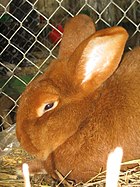 |
9–12 lb
(4.1–5.4 kg) |
Short |
Erect |
Black, Blue, Broken, Red, White |
Yes |
No |
 United States United States
 California California
|
| New Zealand red [UK] |
 |
8 lb
(3.6 kg) |
Short |
Erect |
"Bright golden red or reddish gold with sheen" |
No |
Yes |
 United States United States
 California California
|
| New Zealand white [UK] |
 |
9–12 lb
(4.1–5.4 kg) |
Short |
Erect |
Black, Blue, White |
No |
Yes |
 United States United States
 California California
|
| Nitransky |
Image |
7.7–12.1 lb
(3.5–5.5 kg) |
Short |
Erect |
[White with diluted "Californian" markings] |
No |
No |
 European Union European Union
 Slovenia Slovenia
|
Opossum
See also:
Rex [US] |
Image |
6–8 lb
(2.7–3.6 kg) |
Rex
Curly
Long |
Erect |
"Any [BRC-]recognised colour." |
No |
Yes |
 Switzerland Switzerland
|
| Orange |
Image |
5.5–7.1 lb
(2.5–3.2 kg) |
Short |
Erect |
" A strong and warm yellow-red outer color." |
No |
No |
 European Union European Union
 Sweden Sweden
|
Orylag [fr]
Also called:
Rex du Poitou |
Image |
5.5 lb
(2.5 kg) |
Rex
Straight
Short |
Erect |
[Many] |
No |
No |
 European Union European Union
 France France
|
| Ørestad |
Image |
5.5–7.1 lb
(2.5–3.2 kg) |
Short |
Erect |
Ruby-Eyed White |
No |
No |
 European Union European Union
 Sweden Sweden
|
| Palomino |
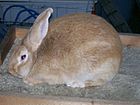 |
10–11 lb
(4.5–5.0 kg) |
Short |
Erect |
Golden, Lynx |
Yes |
No |
 United States United States
 Washington Washington
|
| Pannon White |
Image
|
5–10 lb
(2.3–4.5 kg) |
Short |
Erect |
White |
No |
No |
 European Union European Union
 Hungary Hungary
|
| Perlfee |
Image |
5–8 lb
(2.3–3.6 kg) |
Short |
Erect |
"Blue Agouti" |
No |
Yes |
 United Kingdom United Kingdom
 England England
|
Plush Lop (Miniature)
See also:
Rex [US] |
 |
3.7–4.0 lb
(1.7–1.8 kg) |
Rex
Straight
Short |
Lop |
"Any colour and pattern accepted by the [BRC] apart from the broken pattern." |
No |
No |
 Australia * Australia *
|
Plush Lop (Standard)
See also:
Rex [US] |
Image |
5.1–5.7 lb
(2.3–2.6 kg) |
Rex
Straight
Short |
Lop |
"Any colour and pattern accepted by the [BRC] apart from the broken pattern." |
No |
No |
 Australia * Australia *
|
Pointed Beveren
See also:
Beveren |
 |
7 lb
(3.2 kg) |
Short |
Erect |
Black, Blue, Brown, Lilac |
No |
Yes |
 European Union European Union
 Belgium Belgium
|
Polish [UK]
See also:
Britannia Petite [US] |
 |
2.5 lb
(1.1 kg) |
Short |
Erect |
[Includes >25 different colors/patterns] |
No |
Yes |
 United Kingdom United Kingdom
 England England
|
| Polish [US] |
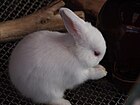 |
2.5–3.5 lb
(1.1–1.6 kg) |
Short |
Erect |
Black, Blue, Blue-Eyed White, Broken, Chocolate, Red-Eyed White |
Yes |
No |
 United Kingdom United Kingdom
 England England
|
Rex [US]
Originally called:
Castorrex
Sometimes called:
Standard Rex
NOTE: To see all breeds with rex fur,
sort on the "Fur Type" column. |
 |
6–10.5 lb
(2.7–4.8 kg) |
Rex
Straight
Short |
Erect |
[Over 19 stated colors/patterns] |
Yes |
No |
 European Union European Union
 France France
|
Rex du Poitou
See main entry:
Orylag |
— |
— |
— |
— |
— |
— |
— |
—
|
Rhinelander
See also:
Rhinsk Schecke [da] |
 |
9–10 lb
(4.1–4.5 kg) |
Short |
Erect |
White with coloured butterfly patterns |
Yes |
Yes |
 European Union European Union
 Germany Germany
|
Rhone [de]
Also called:
Rhön |
Image |
5.5–7.1 lb
(2.5–3.2 kg) |
Short |
Erect |
"A white/black rabbit whose color/pattern is intended to resemble the surface of a birch tree." |
No |
No |
 European Union European Union
 Germany Germany
|
Russian
See main entry:
Himalayan |
— |
— |
— |
— |
— |
— |
— |
—
|
| SA Phendula |
 |
8.8–11.5 lb
(4.0–5.2 kg) |
Short |
Erect |
Chestnut Agouti, Gold or Silver Tipped Steel, Black |
No |
No |
 South Africa South Africa
|
Sachsengold [de]
Also called:
Saxon Gold |
 |
6.1–7.2 lb
(2.75–3.25 kg) |
Short |
Erect |
Chestnut |
No |
No |
 European Union European Union
 Germany Germany
|
| Sallander |
Image |
5–9 lb
(2.3–4.1 kg) |
Short |
Erect |
— |
No |
Yes |
 European Union European Union
 Netherlands Netherlands
|
| San Juan |
Image
|
3–5 lb
(1.4–2.3 kg) |
Short |
Erect |
Agouti |
No |
No |
 United States United States
 Washington Washington
|
Satin [UK]
See also:
Miniature Satin [UK] |
 |
6–8 lb
(2.7–3.6 kg) |
Medium |
Erect |
[Includes >33 different colors/patterns] |
No |
Yes |
 United States United States
 Indiana Indiana
|
Satin [US]
See also:
Mini Satin [US] |
 |
9.5–10 lb
(4.3–4.5 kg) |
Short |
Erect |
Black, Blue, Broken, Californian, Chinchilla, Chocolate, Copper, Lilac(under development), Otter, Red, Siamese, White |
Yes |
No |
 United States United States
 Indiana Indiana
|
| Satin Angora |
 |
6.5–9.5 lb
(2.9–4.3 kg) |
Long |
Erect |
[White or Colored] |
Yes |
No |
 Canada Canada
|
| Schwarzgrannen [UK] [de] |
Image |
4.41–7.17 lb
(2.00–3.25 kg) |
Short |
Erect |
"[P]ure white [with] black ticking" |
No |
Yes |
 European Union European Union
 Germany Germany
|
Separator [DE]
See also:
Beige [UK]
Czech Solver [CZ] |
 |
6.6–8.3 lb
(3–3.75 kg) |
Short |
Erect |
[sandy colored] |
No |
No |
 United Kingdom United Kingdom
|
| Siamese Sable |
 |
5–7 lb
(2.3–3.2 kg) |
Short |
Erect |
Light Siamese Sable, Medium Siamese Sable, Dark Siamese Sable |
No |
Yes |
 European Union European Union
 France France
|
| Siberian |
Image |
5–7 lb
(2.3–3.2 kg) |
Short |
Erect |
Black, Blue, Brown, Lilac |
No |
Yes |
 United Kingdom United Kingdom
 England England
|
Silver [UK]
See also:
Giant Silver |
 |
5–6 lb
(2.3–2.7 kg) |
Short |
Erect |
Blue, Brown, Fawn, Grey |
No |
Yes |
 United Kingdom United Kingdom
 England England
|
Silver [US]
See also:
Giant Silver |
 |
4–7 lb
(1.8–3.2 kg) |
Short |
Erect |
Black, Brown, Fawn |
Yes |
No |
 United Kingdom United Kingdom
 England England
|
Silver Fox [UK]
See main entry:
Fox–Silver [UK] |
— |
— |
— |
— |
— |
— |
— |
—
|
| Silver Fox [US] |
 |
9–12 lb
(4.1–5.4 kg) |
Long |
Erect |
Black, Blue(under development), Chocolate(under development) |
Yes |
No |
 United States United States
 Ohio Ohio
|
Silver Marten
Also called:
Beloresavec [sl]
Weißgrannen [de]
See also:
Big Silver Marten |
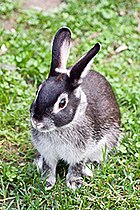 |
9.5 lb
(4.3 kg) |
Short |
Erect |
Black, Blue, Chocolate, Sable |
Yes |
No |
 European Union European Union
 France France
|
| Simenwar |
 |
2.95 lb
(1.337 kg) |
— |
— |
— |
No |
No |
 Egypt Egypt
|
Slovenian Rabbit
Also called:
Slovenski kunec [si] |
Image |
6.6–11.0 lb
(3–5 kg) |
Short |
Erect |
"Blue velvet" with "yellowish-brown" substrate and flecking. [Similar to the "St Hubert" hairshaft?] "The tail and belly are white, and the eyes are brown." |
No |
No |
 European Union European Union
 Slovenia Slovenia
|
Smoke Pearl
Also called:
Sinisoopeli [fi]
Zobel blå [sv]
Zobel blue [da]
See also:
Giant Smoke Pearl |
Image |
5–7 lb
(2.3–3.2 kg) |
Short |
Erect |
Marten type ["smoke in colour, shading to pearl grey beige" with certain white touches, including eye circles] or
Siamese type [same but with no white touches] |
No |
Yes |
 United Kingdom United Kingdom
 Scotland Scotland
|
| Spanish Giant |
Image |
12.5–15 lb
(5.7–6.8 kg) |
Short |
Erect |
— |
No |
No |
 European Union European Union
 Spain Spain
|
| Squirrel |
Image |
5–7 lb
(2.3–3.2 kg) |
Short |
Erect |
— |
No |
Yes |
 United Kingdom United Kingdom
 Scotland Scotland
|
Standard Chinchilla [US]
See also:
Chinchilla |
 |
5–7.5 lb
(2.3–3.4 kg) |
Short |
Erect |
Chinchilla |
Yes |
No |
 European Union European Union
 France France
|
Standard Rex
See main entry:
Rex [US] |
— |
— |
— |
— |
— |
— |
— |
—
|
Stone rabbit
Also called:
Steenkonijn [nl] |
Image |
6.1 lb
(2.75 kg) |
Short |
Erect |
Haaskleur ("hare" = red agouti), Konijngrijs ("rabbit grey" = grey agouti), Ijzergrauw ("iron grey" = steel agouti) |
No |
No |
 European Union European Union
 Belgium Belgium
|
| Sussex |
Image
|
7–8 lb
(3.2–3.6 kg) |
Short |
Erect |
[Shaded] Cream, [Shaded] Gold |
No |
Yes |
 United Kingdom United Kingdom
 England England
|
Swedish Fur
Also called:
Svensk Pels |
Image |
6.6–8.2 lb
(3–3.7 kg) |
Short |
Erect |
"Glossy black with evenly spaced white hair." |
No |
No |
 European Union European Union
 Sweden Sweden
|
Swedish Hare
Includes the breed prev. named:
Elfin |
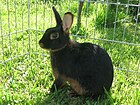 |
5 lb
(2.3 kg) |
Short |
Erect |
All colors and markings are acceptable |
No |
No |
 European Union European Union
 Sweden Sweden
|
| Swiss Fox |
 |
5–8 lb
(2.3–3.6 kg) |
Long |
Erect |
— |
No |
Yes |
 Switzerland Switzerland
|
| Tadla |
Image |
4–5 lb
(1.8–2.3 kg) |
Short |
Erect |
Agouti |
No |
No |
 Morocco Morocco
|
Tan
Also called:
Feu Noir [FR] |
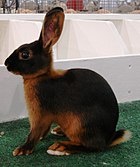 |
4–6 lb
(1.8–2.7 kg) |
Short |
Erect |
Black & Tan, Blue & Tan, Chocolate & Tan, Lilac & Tan |
Yes |
Yes |
 United Kingdom United Kingdom
 England England
|
| Tax-Xiber
|
|
|
|
|
|
|
|
Malta
|
Teddy Dwarf
Also called:
Teddyzwerg [DE] |
 |
1.8–3.7 lb
(0.8–1.7 kg) |
Long |
Erect |
[Many] |
No |
No |
 European Union European Union
 Germany Germany
|
Teddy Lop
Also called:
Teddywidder [DE] |
 |
2.9–4.4 lb
(1.3–2.0 kg) |
Long |
Lop |
[Many] |
No |
No |
 European Union European Union
 Germany Germany
|
| Thrianta |
 |
6 lb
(2.7 kg) |
Short |
Erect |
Chestnut |
Yes |
Yes |
 European Union European Union
 Netherlands Netherlands
|
Thuringer
Also called:
Thüringer |
 |
9 lb
(4.1 kg) |
Short |
Erect |
[Sable with dark points] |
No |
Yes |
 European Union European Union
 Germany Germany
|
Tri-Colour Dutch
Also called:
Harlequin Dutch
Japanese Dutch |
 |
4–5 lb
(1.8–2.3 kg) |
Short |
Erect |
[Tri-Colour Dutch markings] |
No |
Yes |
 United Kingdom United Kingdom
 England England
|
| Tri-Colour English |
 |
6–8 lb
(2.7–3.6 kg) |
Short |
Erect |
[Tri-Colour English markings] |
No |
Yes |
 United Kingdom United Kingdom
 England England
|
| Trønder |
Image |
8.8–13.2 lb
(4–6 kg) |
Short |
Erect |
"The color is shiny black with evenly distributed white hair. The white hairs are white in their full length" |
No |
No |
 Norway Norway
|
V-line
Also called:
Line V |
 |
7.3 lb
(3.32 kg) |
— |
— |
— |
No |
No |
 Egypt Egypt
|
Velveteen Lop
See also:
Rex [US] |
Image |
5–6.5 lb
(2.3–2.9 kg) |
Rex
Straight
Short |
Lop |
[Includes "all patterns and colors of the English Lop breed"] |
No |
No |
 United States United States
|
| Vienna Coloured |
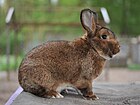 |
7.7–11.6 lb
(3.5–5.25 kg) |
Medium |
Erect |
Agouti, Black, Blue |
No |
Yes |
 European Union European Union
 Austria Austria
|
| Vienna White |
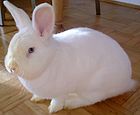 |
7.7–11.6 lb
(3.5–5.25 kg) |
Short |
Erect |
"[P]ure white [...] very lustrous" |
No |
Yes |
 European Union European Union
 Austria Austria
|
| Wheaten |
Image |
5.5–7 lb
(2.5–3.2 kg) |
Short |
Erect |
"Wheaten (the fawn or pale yellow colour of wheat)" |
No |
Yes |
 United Kingdom United Kingdom
|
| Wheaten Lynx |
Image |
5.5–7 lb
(2.5–3.2 kg) |
Short |
Erect |
"Orange-shot-silver" |
No |
Yes |
 United Kingdom United Kingdom
|
White Country
Also called:
Hvid Land [da]
Hvit Land [no]
Vit Lant [se] |
|
8.4–10.1 lb
(3.8–4.6 kg) |
Short |
Erect |
Albino |
No |
No |
 European Union European Union
 Denmark Denmark
|
| Zemmouri |
Image |
4.0–6.4 lb
(1.8–2.9 kg) |
Short |
Erect |
[Black with "Dutch" markings] |
No |
No |
 Morocco Morocco
|
| Zika |
Image |
7.1 lb
(3.2 kg) |
Short |
Erect |
Albino |
No |
No |
 European Union European Union
 Germany Germany
|
